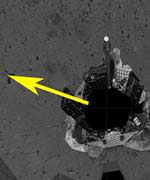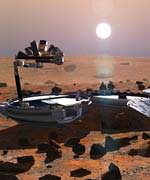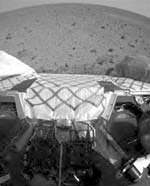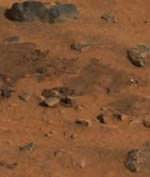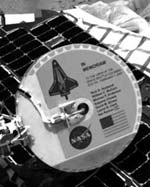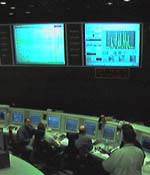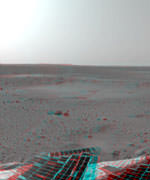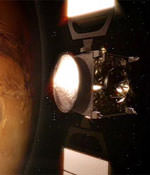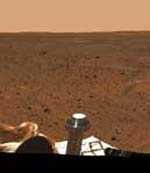
Image credit: NASA/JPL
Mission controllers have released the first panoramic 360-degree view of the Martian landscape taken by the Spirit rover. The colour panorama is a mosaic stitched together from 225 separate images taken by Spirit’s panoramic camera. Not only is it pretty, but it’s a handy tool for the team’s scientists to get an understanding of all the terrain around the rover so they can start prioritizing their targets. One of their greatest interests is how the ground near the rover folded up like a carpet when the lander retracted the airbag. This was totally unexpected, and still a bit of a mystery. Spirit is expected to roll off the lander within two days.
The first 360-degree color view from NASA’s Spirit Mars Exploration Rover presents a range of tempting targets from nearby rocks to hills on the horizon.
“The whole panorama is there before us,” said rover science- team member Dr. Michael Malin of Malin Space Science Systems, San Diego. “It’s a great opening to the next stage of our mission.”
Spirit’s flight team at NASA’s Jet Propulsion Laboratory, Pasadena, Calif., continues making progress toward getting the rover off its lander platform, but expected no sooner than early Thursday morning. “We’re about to kick the baby bird out of its nest,” said JPL’s Kevin Burke, lead mechanical engineer for the rover’s egress off the lander.
The color panorama is a mosaic stitched from 225 frames taken by Spirit’s panoramic camera. It spans 75 frames across, three frames tall, with color information from shots through three different filters. The images were calibrated at Cornell University, Ithaca, N.Y., home institution for Dr. Jim Bell, panoramic camera team leader.
Malin said, “Seeing the panorama totally assembled instead of in individual pieces gives a much greater appreciation for the position of things and helps in developing a sense of direction. I find it easier to visualize where I am on Mars when I can look at different directions in one view. For a field geologist, it’s exactly the kind of thing you want to look at to understand where you are.”
Another new image product from Spirit shows a patch of intriguing soil near the lander in greater detail than an earlier view of the same area. Scientists have dubbed the patch “Magic Carpet” for how some soil behaved when scraped by a retracting airbag.
“It has been detached and folded like a piece of carpet sliding across the floor,” said science-team member Dr. John Grotzinger of Massachusetts Institute of Technology, Cambridge.
Spirit’s next step in preparing to drive onto the surface of Mars is to sever its final connection with the lander platform by firing a cable cutter, which Burke described as “an explosive guillotine.” The planned sequence after that is a turn in place of 115 degrees clockwise, completed in three steps over the next two days. If no obstacles are seen from images taken partway through that turn, drive-off is planned toward the northwestern compass point of 286 degrees.
Spirit landed on Mars Jan. 3 after a seven-month journey. Its task is to spend the next three months exploring rocks and soil for clues about whether the past environment in Gusev Crater was ever watery and suitable to sustain life. Spirit’s twin Mars Exploration Rover, Opportunity, will reach Mars Jan. 24 PST (Jan. 25 Univeral Time and EST) to begin a similar examination of a site on a broad plain called Meridiani Planum, on the opposite side of the planet from Gusev Crater.
NASA JPL, a division of the California Institute of Technology, Pasadena, manages the Mars Exploration Rover project for NASA’s Office of Space Science, Washington. For information about NASA and the Mars mission on the Internet, visit: http://www.nasa.gov. Additional information about the project is available on the Internet at: http://marsrovers.jpl.nasa.gov. Mission information is also available from Cornell University, at: http://athena.cornell.edu.
Original Source: NASA/JPL News Release

